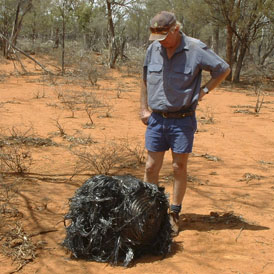Space junk reaches ‘tipping point’, says Nasa expert
The world’s leading expert on space waste has warned that the risk of a disastrous collision between orbiting objects is increasing.
Spacecraft and satellites are in danger of being knocked out of action by thousands of pieces of space junk orbiting the earth, according to a US study.
The amount of debris from spent rockets, obsolete satellites and other pieces of rubbish circling the planet has reached a “tipping point” where a disastrous collision is increasingly likely, the National Research Council report warns.
The numbers of objects measuring 4ins in diameter tracked by the US Space Surveillance Network’s radar sensors has leapt from 9,949 in 2006 to 16,094 last month, with nearly 20 per cent of the objects blamed on China blowing up a defunct weather satellite in a missile test.
The destruction of the Fengynu 1-C satellite created a cloud of more than 3,000 fragments of debris, most of which is likely to stay in orbit for at least a century.
Shortly after the missile test in January 2011, Nasa was forced to manoeuvre its Terra satellite to avoid debris from the explosion.
In 2009, the first major confirmed space junk collision took place, when a working Iridium communications satellite and a non-operational Russian satellite collided 490 miles above Siberia.
The crash created thousands of new pieces of orbital debris, which will then go on to hit each other and form even more shrapnel in a process known as Kessler Syndrome after Nasa scientist Donald Kessler.
The current space environment is growing increasingly hazardous to spacecraft and astronauts. Donald Kessler
The Nasa-sponsored report said computer modelling showed that, even if no more rubbish is put into orbit, the existing amount of junk has already “reached a tipping point, with enough currently in orbit to continually collide and create even more debris, raising the risk of spacecraft failures”.
Before Nasa’s space shuttle fleet was retired, engineers had to replace two windows after every mission on average as a result of strikes from meteorites or orbital debris.
In 2006, the shuttle Atlantis was hit by a small fragment of a circuit board, which punched through the radiator panels in the spacecraft’s cargo bay. The mission almost had to be aborted.
Astronauts on the International Space Station regularly have to swerve the craft out of its normal trajectory to avoid being hit by debris and on two occasions have had to shelter in the Soyuz capsule when they feared a major strike was imminent.
Mr Kessler, the retired head of Nasa’s Orbital Debris Program Office, who led the National Research Council team, said: “The current space environment is growing increasingly hazardous to spacecraft and astronauts.”
Even if the fragments of debris are tiny, they can generate enormous force on impact due to the speed at which objects orbit the earth. In low-earth orbit, space junk typically hurtles through space at around 17,000mph.

Down to earth with a bump
Space junk can pose a hazard to earthlings too, although there have as yet been no reports of death of serious injury from falling debris.
While smaller objects tend to burn up in the Earth’s atmosphere, larger pieces of junk made from materials with a high melting point can survive re-entry.
Booster rocket stages, large pieces of spy satellites, fragments from well-known projects like Mir and Skylab and wreckage from the shuttle Columbia have all fallen to earth.
In 1997 a woman in Oklahoma was hit on the shoulder by a piece of woven material that was later found to be part of a fuel tank that had launched a US Air Force Satellite the year before. She was unhurt.
Cleaning up space
A recent report by the US military’s Defense Advanced Research Projects Agency suggested that efforts to clean up the spaceways should focus on putting the biggest objects out of orbit first.
But scientists have not yet developed the technology to remove space junk.
Suggestions have included: using laser beams based on earth to nudge objects out of the flight paths of satellites; sending interceptor satellites with robotic arms to grab hold of floating debris; using lightweight nets to snare junk, and fitting satellites with balloons that would inflate when they are taken out of service, increasing drag and speeding descent into the Earth’s atmosphere.